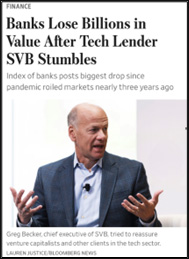CKBlog: The Market
Friday, March 10, 2023
Bank Stocks Swoon
by Charlie Haberstroh, CEO & CIO
The headlines told it all today. From the Wall Street Journal, “Banks Lose Billions in Value after Tech Lender Stumbles”. That tech lender, Silicon Valley Bank (SIVB), certainly stumbled—losing more than 60% of its value in today’s trading session and about 20% more in after-hours trading. Its previous close price was $268 per share and it’s currently trading at $82 per share (which is lower than its price per share  going back to 2016). A combination of events disclosed by SIVB yesterday set the stage for a general sell off in bank stocks today. Big money center banks were down by 5% on average while regional and community banks were down even more. Peers of SIVB that are also considered “tech” related, such as PacWest Bancorp (PACW), were down more than 25%.
going back to 2016). A combination of events disclosed by SIVB yesterday set the stage for a general sell off in bank stocks today. Big money center banks were down by 5% on average while regional and community banks were down even more. Peers of SIVB that are also considered “tech” related, such as PacWest Bancorp (PACW), were down more than 25%.
From 2019 through 2021 SIVB was the darling of Wall Street and Silicon Valley, earnings soared as did deposits and stock price. At its peak in 2021 SIVB reached over $760 per share and was trading at 3.5 times book value when most banks were in the 1 to 1.5 times book value range—even the best of the rest. It was the bank to the Silicon Valley entrepreneurs and their venture capital companies (a very symbiotic relationship which obviously benefited all).
What happened?
First, over the last six months, short-term rates increased dramatically, which has caused all banks to raise bank deposit rates to compete with money market funds and US Treasury Bills. “Free deposits” (read checking accounts) which for the last 10 years had built up (especially in Silicon Valley) in the very low interest rate environment. All banks have had to compete and deposits have become more expensive. As a result, investors fear the difference between what the banks could lend out at and their funds cost to them would narrow considerably.
Second, banks hold certain securities on their balance sheet as a liquidity buffer. Banks are permitted to hold these securities at cost and therefore do not “mark them to market”. This is important, because while the securities in this category are typically low risk and marketable, they are generally not liquidated prior to maturity. The fair value of these securities is revealed in the notes to the financial statements. However, in periods like the last six months where interest rates have moved up quickly and to levels not seen in 15 years, the market value of these securities has dropped pretty precipitously. Not life threatening, and after all, they were not expected to be liquidated before maturity when they could realize full value.
Third, in the case of SIVB and other banks catering to VC and Private Equity firms, the actual companies which had their funds as deposits were experiencing cash burn. The actual balances held by the companies at those banks dropped, necessitating their substitution by other, more expensive sources of funding.
Taken together and divulged by SIVB on March 8th, it decided to “liquify its balance sheet” by selling securities and taking a sizable loss in the process (approximately $1.8 billion). Due to the cash burn of deposits, the desire to restore confidence and to further support liquidity, the bank announced plans to issue common and preferred equity as well as convertible debt. Unfortunately, it seems to have had the opposite effect and clearly triggered a massive sell-off, not only in its own share price, but that of most banks.
As a result, SIVB’s stock now trades at about 50% of book value in nominal terms—quite a nosedive for the former darling. Unfortunately, there are reports that certain VC companies have called for the withdrawal of deposits at the bank, which, if it occurs, will only exacerbate the situation for SIVB and may force more drastic action to stem the liquidity crisis.
What does it mean for the rest of the sector?
- Most banks have a well-diversified deposit base, not concentrated in VC and PE firms, which are “burning” cash. While there has been some runoff of deposits to money market funds and US Treasury securities, it is not as pronounced as in the case of SIVB.
- While the securities held by banks are likely “underwater”, most will hold the securities to maturity and avoid any unnecessary recognition of losses. They have sufficient liquidity. Regardless, the low yields generated by those securities will be a drag, although not a serious one, on bank earnings. This is important to understand because when banks get in trouble, usually the lack of liquidity is the death nell, not insolvency.
It doesn’t seem to me that there is a contagium here. Since the Global Financial Crisis, banks are very liquid and have excellent capital ratios—in fact most are over capitalized and have excess liquidity.
So why did the SPDR S&P Bank ETF (KBE) sell off by over 7% today? In a bear market, sell first and ask questions later. That is not to say that bank stocks will rally on March 10th or that KBE will bounce back. However, I believe that the selling was irrational and, while the uncertainty will likely continue, it may be a buying opportunity for investors with the appropriate risk appetite.
Charles W. K. Haberstroh
CEO and CIO
8:00 EST
March 10, 2023




